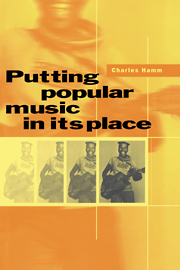Book contents
- Frontmatter
- Contents
- Acknowledgements
- Preface
- 1 Modernist narratives and popular music
- 2 Rock and the facts of life
- 3 Changing patterns in society and music: the US since World War II
- 4 “If I Were a Voice”: or, The Hutchinson Family and popular song as political and social protest
- 5 Some thoughts on the measurement of popularity in music
- 6 Elvis, a review
- 7 Home cooking and American soul in black South African popular music
- 8 Rock ‘n’ roll in a very strange society
- 9 African-American music, South Africa, and apartheid
- 10 “The constant companion of man”: Separate Development, Radio Bantu, and music
- 11 Privileging the moment of reception: music and radio in South Africa
- 12 Music and radio in the People's Republic of China
- 13 Towards a new reading of Gershwin
- 14 A blues for the ages
- 15 Graceland revisited
- 16 Dvořák in America: nationalism, racism, and national race
- 17 The last minstrel show?
- 18 The Role of Rock, a review
- 19 Genre, performance, and ideology in the early songs of Irving Berlin
- 20 Epilogue: John Cage revisited
- Index
10 - “The constant companion of man”: Separate Development, Radio Bantu, and music
Published online by Cambridge University Press: 05 February 2012
- Frontmatter
- Contents
- Acknowledgements
- Preface
- 1 Modernist narratives and popular music
- 2 Rock and the facts of life
- 3 Changing patterns in society and music: the US since World War II
- 4 “If I Were a Voice”: or, The Hutchinson Family and popular song as political and social protest
- 5 Some thoughts on the measurement of popularity in music
- 6 Elvis, a review
- 7 Home cooking and American soul in black South African popular music
- 8 Rock ‘n’ roll in a very strange society
- 9 African-American music, South Africa, and apartheid
- 10 “The constant companion of man”: Separate Development, Radio Bantu, and music
- 11 Privileging the moment of reception: music and radio in South Africa
- 12 Music and radio in the People's Republic of China
- 13 Towards a new reading of Gershwin
- 14 A blues for the ages
- 15 Graceland revisited
- 16 Dvořák in America: nationalism, racism, and national race
- 17 The last minstrel show?
- 18 The Role of Rock, a review
- 19 Genre, performance, and ideology in the early songs of Irving Berlin
- 20 Epilogue: John Cage revisited
- Index
Summary
My study of the South African government's media strategy continued when I arrived in Grahamstown in August of 1984 to take up a post as Visiting Scholar at the Institute for Social and Economic Research at Rhodes University.
It was a time of historic confrontation in South Africa. A new black strategy of forcing political change by making the townships ungovernable brought a deadly spiral of violence. Resistance to the presence of security forces in the townships resulted in deaths of demonstrators and bystanders; funerals of these victims turned into even greater outpouring of outrage and frustration, bringing fresh clashes with security forces. Blacks collaborating with the government and its agencies were attacked and killed by fellow blacks. A state of emergency was declared throughout the country, and thousands of political and community leaders were detained without being charged or brought to trial. Resistance leaders, black and white, disappeared or died in apparent accidents, subsequently linked to security forces and paramilitary pro-apartheid groups.
Though public concerts in the black townships were impossible under such conditions, music continued to play a central role in the struggle for political power. Syncretic black “freedom songs” and hymns such as “Nkosi Sikelel' i Africa,” the anthem of the African National Congress, accompanied rallies and funerals throughout the country.
- Type
- Chapter
- Information
- Putting Popular Music in its Place , pp. 210 - 248Publisher: Cambridge University PressPrint publication year: 1995
- 1
- Cited by

